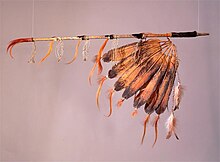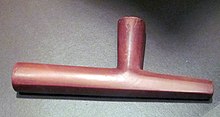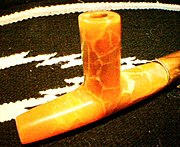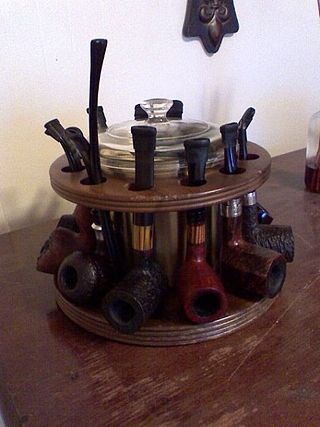
A tobacco pipe, often called simply a pipe, is a device specifically made to smoke tobacco. It comprises a chamber for the tobacco from which a thin hollow stem (shank) emerges, ending in a mouthpiece. Pipes can range from very simple machine-made briar models to highly prized hand-made artisanal implements made by renowned pipemakers, which are often very expensive collector's items. Pipe smoking is the oldest known traditional form of tobacco smoking.

Catlinite, also called pipestone, is a type of argillite, usually brownish-red in color, which occurs in a matrix of Sioux Quartzite. Because it is fine-grained and easily worked, it is prized by Native Americans, primarily those of the Plains nations, for use in making ceremonial pipes, known as chanunpas or čhaŋnúŋpas in the Lakota language. Pipestone quarries are located and preserved in Pipestone National Monument outside Pipestone, Minnesota, in Pipestone County, Minnesota, and at the Pipestone River in Ontario, Canada.

Pipestone National Monument is located in southwestern Minnesota, just north of the city of Pipestone, Minnesota. It is located along the highways of U.S. Route 75, Minnesota State Highway 23 and Minnesota State Highway 30. The quarries are sacred to many tribal nations of North America, including the Dakota, Lakota, and other tribes of Native Americans, and were considered neutral territory in the historic past where all Nations could quarry stone for ceremonial pipes. The catlinite, or "pipestone", is traditionally used to make ceremonial pipes, vitally important to traditional Plains Indian religious practices. Archeologists believe the site has been in use for over 3000 years with Minnesota pipestone having been found inside North American burial mounds dated much earlier.

A chillum, or chilam, is a straight conical smoking pipe traditionally made of either clay or a soft stone. It was used popularly in India in the eighteenth century and still often used to smoke marijuana. A small stone is often used as a stopper in the stem. The style of pipe spread to Africa, and has been known in the Americas since the 1960s. A chillum pipe is used in Rastafari rituals.

A meerschaum pipe is a smoking pipe made from the mineral sepiolite, also known as meerschaum. Meerschaum is sometimes found floating on the Black Sea and is rather suggestive of sea foam.

Pipe smoking is the practice of tasting the smoke produced by burning a substance, most commonly tobacco and cannabis, in a pipe. It is the oldest traditional form of smoking.

Ute are the Indigenous people of the Ute tribe and culture among the Indigenous peoples of the Great Basin. They had lived in sovereignty in the regions of present-day Utah and Colorado in the Southwestern United States for many centuries until Europeans settled on their lands. The state of Utah is named after the Ute tribe.
Chanunpa, is the Lakota language name for the sacred, ceremonial pipe and the ceremony in which it is used. The pipe ceremony is one of the Seven Sacred Rites of the Lakota people. Lakota tradition has it that White Buffalo Calf Woman brought the chanunpa to the people, as one of the Seven Sacred Rites, to serve as a sacred bridge between this world and Wakan Tanka, the "Great Mystery".

Spiro Mounds is an archaeological site located in present-day eastern Oklahoma that remains from an indigenous Indian culture that was part of the major northern Caddoan Mississippian culture. The 80-acre site is located within a floodplain on the southern side of the Arkansas River. The modern town of Spiro developed approximately seven miles to the south.

Smudging, or other rites involving the burning of sacred herbs or resins, is a ceremony practiced by some Indigenous peoples of the Americas. While it bears some resemblance to other ceremonies and rituals involving smoke from other world cultures, notably those that use smoke for spiritual cleansing or blessing, the purposes and particulars of the ceremonies, and the substances used, can vary widely among tribes, bands, and nations, and even more so among different world cultures. In traditional communities, Elders maintain the protocols around these ceremonies and provide culturally specific guidance. The smudging ceremony, by various names, has been appropriated by others outside of the Indigenous communities as part of New Age or commercial practices, which has also led to the over-harvesting of some of the plants used in ceremonies. The appropriation and the over-harvesting have both been protested by Indigenous people in the US and Canada.

A bowl, when referred to in pipe smoking, is the part of a smoking pipe or bong that is used to hold tobacco, cannabis, or other substances.

A smoking pipe is used to taste the smoke of a burning substance; most common is a tobacco pipe,. Pipes are commonly made from briar, heather, corn, meerschaum, clay, cherry, glass, porcelain, ebonite and acrylic.
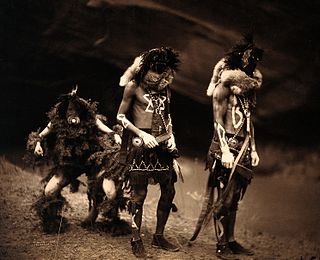
Native American religions are the spiritual practices of the Native Americans in the United States. Ceremonial ways can vary widely and are based on the differing histories and beliefs of individual nations, tribes and bands. Early European explorers describe individual Native American tribes and even small bands as each having their own religious practices. Theology may be monotheistic, polytheistic, henotheistic, animistic, shamanistic, pantheistic or any combination thereof, among others. Traditional beliefs are usually passed down in the forms of oral histories, stories, allegories, and principles.

Haida argillite carvings are a sculptural tradition among the Haida indigenous nation of the Northwest Coast of North America. It first became a widespread art form in the early 19th century, and continues today.

The Sioux Quartzite is a Proterozoic quartzite that is found in the region around the intersection of Minnesota, South Dakota, and Iowa, and correlates with other rock units throughout the upper midwestern and southwestern United States. It was formed by braided river deposits, and its correlative units are thought to possibly define a large sedimentary wedge that once covered the passive margin on the then-southern side of the North American craton. In human history, it provided the catlinite, or pipestone, that was used by the Plains Indians to carve ceremonial pipes. With the arrival of Europeans, it was heavily quarried for building stone, and was used in many prominent structures in Sioux Falls, South Dakota and shipped to construction sites around the Midwest. Sioux Quartzite has been and continues to be quarried in Jasper, Minnesota at the Jasper Stone Company and Quarry, which itself was posted to the National Register of Historic Places on January 5, 1978. Jasper, Minnesota contains many turn-of-the-century quartzite buildings, including the school, churches and several other public and private structures, mostly abandoned.
Cresson is an unincorporated community located in Pipestone County, Minnesota, United States. The elevation is 1,673 feet. Cresson appears on the Elkton SW U.S. Geological Survey Map.
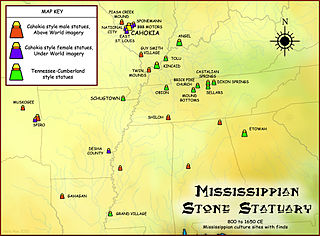
The Mississippian stone statuary are artifacts of polished stone in the shape of human figurines made by members of the Mississippian culture and found in archaeological sites in the American Midwest and Southeast. Two distinct styles exist; the first is a style of carved flint clay found over a wide geographical area but believed to be from the American Bottom area and manufactured at the Cahokia site specifically; the second is a variety of carved and polished locally available stone primarily found in the Tennessee-Cumberland region and northern Georgia. Early European explorers reported seeing stone and wooden statues in native temples, but the first documented modern discovery was made in 1790 in Kentucky, and given as a gift to Thomas Jefferson.
Kinnikinnick is a Native American and First Nations herbal smoking mixture, made from a traditional combination of leaves or barks. Recipes for the mixture vary, as do the uses, from social, to spiritual to medicinal.
The Barron County Pipestone Quarry is a sacred site in Native American history located in Doyle, Wisconsin, United States. It was added to the National Register of Historic Places in 1978.

The World's Largest Peace Pipe is a statue of a ceremonial pipe in Pipestone, Minnesota, United States. It began with a vision shared by three spiritual people: one Lakota and two Anishinaabe. The pipe stands on the grounds of the historic Rock Island Railroad depot near the entrance to Pipestone National Monument, home to the Keepers of the Sacred Tradition of Pipemakers. The location of the giant peace pipe is significant; the pipestone quarry nearby is known as "the crossroads of the Indian world." The soft red catlinite from the quarry has been used by American Indians for thousands of years to create ceremonial peace pipes.
